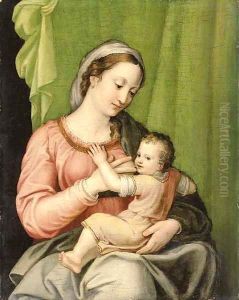Sebastiano Filippi (Bastianino) Paintings
Sebastiano Filippi, better known as Bastianino, was an Italian painter of the Renaissance period, active mainly in his hometown of Ferrara, Italy. Born in 1536 to a family with artistic ties—his father, Camillo Filippi, was a painter—Bastianino was immersed in the world of art from an early age. His initial training was under the guidance of his father, which would later be reflected in the younger Filippi's mastery of color and composition.
Bastianino's work is often characterized by the fusion of Ferrarese painterly traditions and the influence of the Roman Mannerist style. His exposure to the works of Michelangelo, particularly the frescoes of the Sistine Chapel during a visit to Rome, had a profound impact on his artistic development. Bastianino's style is noted for its dramatic use of perspective and the muscularity of his figures, which clearly echo the grandeur and the dynamism found in Michelangelo's work.
Throughout his career, Bastianino received numerous commissions for religious works, including altarpieces and frescoes for churches and cathedrals. One of his most significant and ambitious projects was the fresco cycle in the Cathedral of Ferrara, where he painted 'The Last Judgment' on the cathedral's dome, drawing comparisons to Michelangelo's own 'The Last Judgment' in the Sistine Chapel. This monumental work is considered his masterpiece and is a testament to his skill in handling large-scale compositions and his profound understanding of Biblical iconography.
Despite his evident talent and some significant commissions, Bastianino did not achieve the same level of fame as some of his contemporaries. However, his works have been appreciated for their emotional intensity and technical skill. Bastianino's contributions to the Ferrarese school of painting are significant, and his works can still be viewed in various churches and museums, preserving his artistic legacy.
Sebastiano Filippi died in 1602, leaving behind a body of work that, while not as widely known as that of some of his peers, demonstrates the rich and complex interplay of local and international influences that characterized the world of Renaissance art in Italy. His paintings continue to be studied and admired for their complexity, vigor, and the unique blend of regional and Michelangelesque elements.
